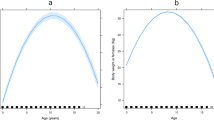Abstract
Many previous studies have pointed out that, when resources are limited, the potential for competition should be high among sympatric species that display overlaps in habitat and nutritional niches. However, reliable evidence of competition between red deer (Cervus elaphus) and roe deer (Capreolus capreolus) has not been yet reported for life history traits directly measuring performance such as body mass, reproduction, or survival. From long-term monitoring of deer populations in the reserve of La Petite Pierre (France), we measured the sex-specific responses of roe deer fawn body mass to changes in red deer density after accounting for possible confounding effects of date of shooting, climatic conditions, and roe deer density. As expected under the hypothesis of competition, red deer density in a given year had a marked negative influence on body mass of roe deer fawns born the same year and the following year. Fawn mass of roe deer males and females responded in similar ways to changes in red deer density. Our study provides the first evidence of a negative response of roe deer performance to high red deer density.


Similar content being viewed by others
References
Acevedo P, Ruiz-Fons F, Vicente J, Reyes-Garcia AR, Alzaga V, Gortazar C (2008) Estimating red deer abundance in a wide range of management situations in Mediterranean habitats. J Zool 276:37–47
Andersen R, Gaillard JM, Liberg O, San Jose C (1998) Variations in life history parameters. In: Andersen R, Duncan P, Linnell JDC (eds) The European roe deer: the biology of success. Scandinavian University Press, Oslo, pp 285–307
Andersen R, Gaillard JM, Linnell JDC, Duncan P (2000) Factors affecting maternal care in an income breeder, the European roe deer. J Anim Ecol 69:672–682
Baltzinger C (2003) Sélection des sites de repos par le cerf (Cervus elaphus) et le chevreuil (Capreolus capreolus) en forêt tempérée de moyenne montagne. PhD thesis, Ecole Nationale du Génie Rural, des Eaux et des Forêts, Paris
Bartos L, Vankova D, Miller KV, Siler J (2002) Interspecific competition between white-tailed, fallow, red, and roe deer. J Wildl Manage 66:522–527
Begon M, Townsend CR, Harper JL (2006) Ecology from individuals to ecosytems. Blackwell, Oxford
Bonenfant C, Gaillard JM, Loison A, Klein F (2002) Sex- and age-dependent effects of population density on life history traits of red deer (Cervus elaphus) in a temperate forest. Ecography 25:446–458
Bonenfant C, Gaillard JM, Coulson T, Festa-Bianchet M, Loison A, Garel M, Loe LE, Blanchard P, Pettorelli N, Owen-Smith N, Du Toit J, Duncan P (2009) Empirical evidence of density-dependence in population of large herbivores. Adv Ecol Res 41:313–357
Burnham KP, Anderson DR (2002) Model selection and multimodel inference, a practical information theoretic approach. Springer Science, New York
Caughley G (1977) Analysis of vertebrate populations. Wiley, Chichester
Clutton-Brock TH, Albon SD, Guinness FE (1988) Reproductive success in male and female red deer. In: Clutton-Brock TH (ed) Reproductive success. University of Chicago Press, Chicago, pp 325–343
Crawley MJ (2007) The R book. Wiley, Chichester
Dolman PM, Wäber K (2008) Ecosystem and competition impacts of introduced deer. Wildl Res 35:202–214
du Toit JT, Owen-Smith N (1989) Body size, population metabolism and habitat specialization among African large herbivores. Am Nat 133:736–740
Ferretti F, Sforzi A, Lovari S (2008) Intolerance amongst deer species at feeding: roe deer are uneasy banqueters. Behav Processes 78:487–491
Flerov KK (1952) Fauna of USSR. In: Mammals, vol 1, No 2. New Series 55. Academy of Sciences of the USSR, Moscow, USSR
Focardi S, Aragno P, Montanaro P, Riga F (2006) Inter-specific competition from fallow deer Dama dama reduces habitat quality for the Italian roe deer Capreolus capreolus italicus. Ecography 29:407–417
Fowler CW (1987) A review of density dependence in population of large mammals. In: Genoway HH (ed) Current mammalogy. Plenum, New York, pp 401–441
Gaillard JM, Delorme D, Jullien JM (1993) Effects of cohort, sex, and birth date on body development of roe deer (Capreolus capreolus) fawns. Oecologia 94:57–61
Gaillard JM, Delorme D, Boutin JM, van Laere G, Boisaubert B (1996) Body mass of roe deer fawns during winter in 2 contrasting populations. J Wildl Manage 60:29–36
Gaillard JM, Boutin JM, Delorme D, van Laere G, Duncan P, Lebreton JD (1997) Early survival in roe deer: causes and consequences of cohort variation in two contrasted populations. Oecologia 112:502–513
Gaillard JM, Liberg O, Andersen R, Hewison AMJ (1998) Population dynamics of roe deer. In: Andersen R, Duncan P, Linnell JDC (eds) The European roe deer: the biology of success. Scandinavian University Press, Oslo, pp 309–336
Gaillard JM, Duncan P, Delorme D, van Laere G, Pettorelli N, Maillard D, Renaud G (2003) Effects of hurricane Lothar on the population dynamics of European roe deer. J Wildl Manage 67:767–773
Garel M, Loison A, Gaillard JM, Cugnasse JM, Maillard D (2004) The effects of a severe drought on mouflon lamb survival. Proc R Soc Lond Ser B 271:471–473
Garel M, Bonenfant C, Hamann JL, Klein F, Gaillard JM (2010) Are abundance indices derived from spotlight counts reliable to monitor red deer populations? Wildl Biol 16(1) (in press)
Gill RMA (1990) Monitoring the status of European and North American cervids, Nairobi, Kenya
Hamann JL, Klein F, Saint-Andrieux C (1997) Domaine vital diurne et déplacements des biches (Cervus elaphus) sur le secteur de la Petite Pierre (Bas Rhin). Gibier Faune Sauvage 14:1–17
Hemami MR, Watkinson AR, Dolman PM (2004) Habitat selection by sympatric muntjac (Muntiacus reevesi) and roe deer (Capreolus capreolus) in a lowland commercial pine forest. For Ecol Manage 194:49–60
Hewison AJM, Gaillard JM, Angibault JM, van Laere G, Vincent JP (2002) The influence of density on post-weaning growth in roe deer Capreolus capreolus fawns. J Zool 257:303–309
Hofmann RR (1989) Evolutionary steps of ecophysiological adaptation and diversification of ruminants: a comparative view of their digestive system. Oecologia 78:443–457
Jarman PJ (1974) Social organization of antelope in relation to their ecology. Behaviour 48:215–267
Johnson BK, Kern JW, Wisdom MJ, Findholt SL, Kie JG (2000) Resource selection and spatial separation of mule deer and elk during spring. J Wildl Manage 64:685–697
Kjellander P, Gaillard JM, Hewison AJM (2006) Density-dependent responses of fawn cohort body mass in two contrasting roe deer populations. Oecologia 146:521–530
Latham J (1999) Interspecific interactions of ungulates in European forests: an overview. For Ecol Manage 120:13–21
Latham J, Staines BW, Gorman ML (1997) Correlations of red (Cervus elaphus) and roe (Capreolus capreolus) deer densities in Scottish forests with environmental variables. J Zool 242:681–704
Latham J, Staines BW, Gorman ML (1999) Comparative feeding ecology of red (Cervus elaphus) and roe deer (Capreolus capreolus) in Scottish plantation forests. J Zool 247:409–418
Marshal JP, Bleich VC, Andrew NG (2008) Evidence for interspecific competition between feral ass Equus asinus and mountain sheep Ovis canadensis in a desert environment. Wildl Biol 14:228–236
Milner JM, Pemberton JM, Brotherstone S, Albon SD (2000) Estimating variance components and heritabilities in the wild: a case study using the “animal model” approach. J Evol Biol 13:804–813
Morellet N, Gaillard JM, Hewison AJM, Ballon P, Boscardin Y, Duncan P, Klein F, Maillard D (2007) Indicators of ecological change: new tools for managing populations of large herbivores. J Appl Ecol 44:634–643
Mysterud A, Ostbye E (2006) Effect of climate and density on individual and population growth of roe deer Capreolus capreolus at northern latitudes: the Lier valley, Norway. Wildl Biol 12:321–329
Mysterud A, Perez-Barberia FJ, Gordon IJ (2001) The effect of season, sex and feeding style on home range area versus body mass scaling in temperate ruminants. Oecologia 127:30–39
Owen-Smith N (2002) Adaptative herbivore ecology. Cambridge University Press, Cambridge
Perez-Barberia FJ, Perez-Fernandez E, Robertson E, Alvarez-Enriquez B (2008) Does the Jarman-Bell principle at intra-specific level explain sexual segregation in polygynous ungulates? Sex differences in forage digestibility in Soay sheep. Oecologia 157:21–30
Pettorelli N, Gaillard JM, Duncan P, Ouellet JP, van Laere G (2001) Population density and small-scale variation in habitat quality affect phenotypic quality in roe deer. Oecologia 128:400–405
Pettorelli N, Gaillard JM, van Laere G, Duncan P, Kjellander P, Liberg O, Delorme D, Maillard D (2002) Variations in adult body mass in roe deer: the effects of population density at birth and of habitat quality. Proc R Soc Lond Ser B 269:747–753
Pettorelli N, Gaillard JM, Duncan P, Maillard D, van Laere G, Delorme D (2003) Age and density modify the effects of habitat quality on survival and movements of roe deer. Ecology 84:3307–3316
Pettorelli N, et al. (2006) Using a proxy of plant productivity (NDVI) to find key periods for animal performance: the case of roe deer. Oikos 112:565–572
Portier C, Festa-Bianchet M, Gaillard JM, Jorgenson JT, Yoccoz NG (1998) Effects of density and weather on survival of bighorn sheep lambs (Ovis canadensis). J Zool 245:271–278
Putman R (1996) Competition and resources partitioning in temperate ungulate assemblies. Chapman & Hall, London
Staines BW, Welch D (1984) Habitat selection and impact of red (Cervus elaphus L.) and roe (Capreolus capreolus L.) deer in a Sitka spruce plantation. Proc R Soc Edin Sec B 82:303–319
Storms D, Said S, Fritz H, Hamann JL, Saint-Andrieux C, Klein F (2006) Influence of hurricane Lothar on red and roe deer winter diets in the Northern Vosges, France. For Ecol Manage 237:164–169
Storms D, et al. (2008) Seasonal variation in diet composition and similarity of sympatric red deer Cervus elaphus and roe deer Capreolus capreolus. Wildl Biol 14:237–250
R Development Core Team (2008) R: a language and environment for statistical computing. R Foundation for Statistical Computing, Vienna http://R-projectorg
Therrien JF, Côté SD, Festa-Bianchet M, Ouellet JP (2007) Conservative maternal care in an iteroparous mammal: a resource allocation experiment. Behav Ecol Sociobiol 62:193–199
Toïgo C, Gaillard JM, van Laere G, Hewison M, Morellet N (2006) How does environmental variation influence body mass, body size, and body condition? Roe deer as a case study. Ecography 29:301–308
Van der Wal R, Van Wijnen H, Van Wieren S, Beucher O, Bos D (2000) On facilitation between herbivores: how brent geese profit from brown hares. Ecology 81:969–980
Van Soest PJ (1996) Allometry and ecology of feeding behavior and digestive capacity in herbivores: a review. Zoo Biol 15:455–479
Welch D, Staines BW, Catt DC, Scott D (1990) Habitat usage by red (Cervus elaphus) and roe (Capreolus capreolus) deer in a Scottish Sitka spruce plantation. J Zool 221:453–476
Widmer O, Said S, Miroir J, Duncan P, Gaillard JM, Klein F (2004) The effects of hurricane Lothar on habitat use of roe deer. For Ecol Manage 195:237–242
Acknowledgements
Funding was provided by the Office National de la Chasse et de la Faune Sauvage (ONCFS). The national reserve is managed by the ONCFS and the Office National des Forêts. We are grateful to wildlife technicians, foresters and many volunteers for help in counts. We are also grateful to hunters for having taken measurements on roe deer fawns. We thank Christophe Bonenfant, Mathieu Garel, and the members of the GROS research group for stimulating discussions. Finally, we thank Atle Mysterud and one anonymous reviewer for their comments.
Author information
Authors and Affiliations
Corresponding author
Additional information
Communicated by Jörg Ganzhorn.
Rights and permissions
About this article
Cite this article
Richard, E., Gaillard, JM., Saïd, S. et al. High red deer density depresses body mass of roe deer fawns. Oecologia 163, 91–97 (2010). https://doi.org/10.1007/s00442-009-1538-z
Received:
Accepted:
Published:
Issue Date:
DOI: https://doi.org/10.1007/s00442-009-1538-z




